Brilliant Blue Stripes in Limpet Shells Reveal Secret to Augmented Reality
| Ana Verayo | | Feb 27, 2015 05:42 AM EST |
(Photo : Wikimedia) The blue rayed limpet exudes brilliant blue lines that can be mimicked in transparent displays.
Scientists believe limpet shells can serve as an inspiration in developing advanced optical biomaterials.
The illuminated blue lines of the limpet's shells are apparently created by a pair of optical structures newly discovered by researchers. These features run across the shells in parallel lines and act as reflectors under muddy waters.
Like Us on Facebook
Researchers from the Massachusetts Institute of Technology (MIT) and Harvard University examined these shells and their structures to determine what makes these features glow underwater even in extremely low light.
Using a high resolution 2D and 3D structural analysis, researchers observed the nanoarchitecture of the mollusks. They saw the top layer was composed of calcium carbonate platelets followed by a zigzag pattern underneath the platelets and over spherical particles.
Researchers found out that the angle of the diagonal patterns were placed in such a way that it reflects the most blue light possible and the structures absorb all colors and produces distinct strips of blue light reflected on the shell.
This blue rayed limpet mollusk is indigenous to the kelp bed rich waters in Iceland and Norway and other countries such as the U.K., Portugal and the Canary Islands.
Researchers believe these blue stripes found across the shells help pull-off a disguise that makes the limpet resemble soft bodied snails that are poisonous to most predators.
These limpet shells are the first animal species to exhibit unique colors using structures built from inorganic minerals. Other animals also exude brilliant arrays of color such as butterflies' wings and birds' feathers. These arrays, however, are still considered biological features.
This unique limpet shell technology can be applied to similar structures with transparent displays such as vehicular windshields and windows. These displays can also be controlled in order to show maps, weather updates or other information so drivers can navigate easily under less than ideal conditions.
This can very well be the link to augmented reality where a driver can see the outside world using this special window while driving and using a projected map on the windshield, as well, according to Mathias Kolle from MIT. This system will also require a light source.
This study was published in the journal, Nature Communications.
Tagsblue rayed limpet, shells mollusks blue stripes lines augmented reality transparent displays, Brilliant Blue Stripes from Mollusk Reveal Secret to Augmented Reality, limpet shell
©2015 Chinatopix All rights reserved. Do not reproduce without permission
EDITOR'S PICKS
-

Did the Trump administration just announce plans for a trade war with ‘hostile’ China and Russia?
-

US Senate passes Taiwan travel bill slammed by China
-

As Yan Sihong’s family grieves, here are other Chinese students who went missing abroad. Some have never been found
-

Beijing blasts Western critics who ‘smear China’ with the term sharp power
-

China Envoy Seeks to Defuse Tensions With U.S. as a Trade War Brews
-

Singapore's Deputy PM Provides Bitcoin Vote of Confidence Amid China's Blanket Bans
-

China warns investors over risks in overseas virtual currency trading
-

Chinese government most trustworthy: survey
-

Kashima Antlers On Course For Back-To-Back Titles
MOST POPULAR
LATEST NEWS
Zhou Yongkang: China's Former Security Chief Sentenced to Life in Prison

China's former Chief of the Ministry of Public Security, Zhou Yongkang, has been given a life sentence after he was found guilty of abusing his office, bribery and deliberately ... Full Article
TRENDING STORY

China Pork Prices Expected to Stabilize As The Supplies Recover

Elephone P9000 Smartphone is now on Sale on Amazon India

There's a Big Chance Cliffhangers Won't Still Be Resolved When Grey's Anatomy Season 13 Returns

Supreme Court Ruled on Samsung vs Apple Dispute for Patent Infringement

Microsoft Surface Pro 5 Rumors and Release Date: What is the Latest?










